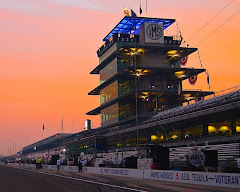
Mike King is a nice guy and a competent announcer for the IMS Radio Network. He is also a pliant company man. Citizens can therefore assume that his public statements provide a reliable approximation of whatever it is that the IndyCar bosses are thinking.
Right now, they are apparently thinking that more road and street racing is a splendid business proposition for the IndyCar Series.
Pete Pistone of CBS Sportsline recently argued that IndyCar should embrace ovals because the racing is fantastic. We agree with Pistone's conclusion, even if it is the product of hopelessly muddled logic.
King responded in
Pistone's mailbag this week, suggesting among other things that road and street circuits are preferred because they have attracted greater attendance than ovals this season.
Mike King, Market Analyst: "Ovals, Bad"
King offers arguments that are convincing only on a strictly
prima facie level. Attendance at IndyCar oval races at Kansas, Kentucky and Chicagoland was undeniably awful in 2009. But he seems to conclude that these tracks are somehow unable to draw an audience that would match those that attend events at road and temporary circuits.
We know that this is false because Kansas, Kentucky and Chicagoland
have attracted large IndyCar crowds in the recent past. We know this not only because it is confirmed by data, but also because we were there.
The problem is that IndyCar racing is no longer a product that is
designed to appeal to fans of oval racing. It is a road racing product. There is no counter-argument: one need only examine the schedule and the roster of drivers. - Roggespierre
Recall, too, that races at Kansas, Kentucky and Chicagoland early this decade drew better TV ratings - the primary profit lever, by far, for any racing series - than the non-Indy events today. Moreover, those ratings were achieved despite the presence of an exquisitely capitalized competitor and captured media that dedicated more effort to destroying the original IRL model than to growing its own business.
Incidentally, many of those guys are now pulling the strings that manipulate the Indy Racing League.
Like we said, King is a pliant company man.
Mike King, Market Analyst: "Road & Temporary Circuits, Good"King also engages in puffery, suggesting that the crowds at St. Pete, Long Beach, Edmonton and Mid-Ohio were "phenomenal."
Frankly, attendance had better be phenomenal at those events. We reiterate that IndyCar is a road racing product. Therefore, if it fails to attract crowds and television viewers who enjoy road racing, then IndyCar is an even greater market failure than we had previously believed.
The crowds looked just okay from our vantage point. Attendance at Mid-Ohio obviously declined year-over-year despite ample comp ticket distributions by Honda and Firestone. Edmonton, insolvent and requiring subsidies from more than one government entity, drew a crowd that would be considered mediocre at a large oval track. But it looks fine at an airport, where seating capacity can be adjusted for appearance's sake.
The course at St. Pete renders audience estimation nearly impossible, and we suspect that is the idea exactly. We can report that the locals in the Tampa Bay region are not particularly impressed. If not for the rivalry among local municipalities, then the event likely would not survive. It might not survive, anyway.
Warning to the IRL - St. Petersburg, Florida is engaged in a heated mayoral race. Citizens there are not pleased with the direction. This is unfortunate because your event is and has been part of that direction. If there is to be a new mayor, then we suggest that you begin smooching his
derriere with some haste or risk losing public assistance. You might also want to contribute to the campaigns of each mayoral candidate, just in case.
Mike King: Taking what they're Giving & Working for a LivingKing does make some salient points. For example, he wrote to Pistone that IndyCar events that are paired with ARCA and other stock car series have not been successful. We agree. IndyCar is not a stock car series and is unlikely to draw many stock car fans.
Unfortunately, King's overlords would like to have us believe that Stock Car Fans and Oval Racing Fans are one and the same. This is false.
If such an assumption were correct, then the early IRL would not have been a more successful television product than the present iteration. It would not have earned crowds of approximately 60,000 at Kansas, Kentucky and Chicagoland - each without the benefit of government subsidies.
If NASCAR Fans and Oval Fans were homogenous, then the Indianapolis 500 could not possibly exist. Perhaps that is the intent.
By the way, 60,000 was the estimated attendance at the "phenomenally" successful Edmonton event this year. Is there any reason to believe that St. Pete and Mid-Ohio attracted 60,000 paying customers?
Like we said, King provides a reliable approximation of whatever it is that the IndyCar bosses are thinking.
He will never be a market analyst. But he will keep his job.
Roggespierre













